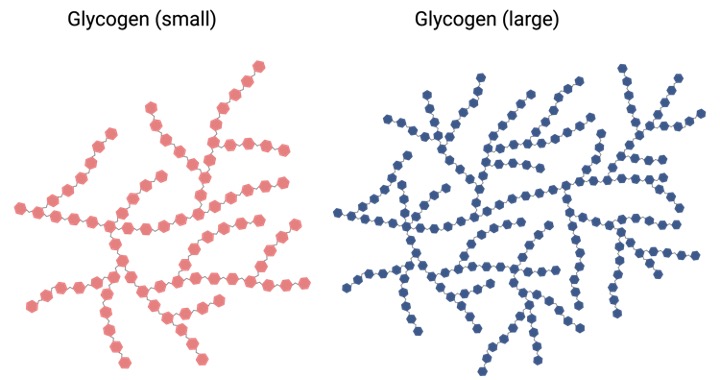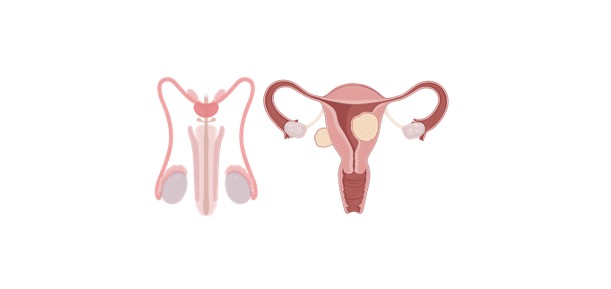Table of Contents
Glycogen Definition
Glycogen is a polymer of glucose. The liver and muscle cells produce glycogen. It acts as a stored energy form or secondary energy storage in animal cells.
What is Glycogen?
Glycogen is a member of the polysaccharide group of carbohydrates. Carbohydrates are one of the major classes of biomolecules that act as an energy source in plants and animals. The molecule is comprised of oxygen, hydrogen, and carbon in the ratio of 1:2:1. The carbohydrates include simple sugar and complex sugar.

Simple sugars can be easily digested and made up of one or two monosaccharide residues thus they are used as an energy source whereas complex sugars cannot be digested easily. Examples of complex carbohydrates include cellulose, starch, chitin, and glycogen that are rich in fibers.
History and Terminology of Glycogen
Glycogen was first discovered by French physiologist Claude Bernard in 1857. He described the method of isolation of substance from liver. He named it a “sugar-forming substance”. Later, in 1858, the German organic chemist Friedrich August Kekule described the chemical formula of glycogen (C6H10O5).
Characteristics of Glycogen
Glycogen act as a major energy reserve in animals. It is a complex carbohydrate referred to as animal starch due to its structure and function. It reserves excess glucose in animals. However, the extensive branching of glycogen differs from the starch. The monomeric units of glycogen are connected by α (1-4) glycosidic bonds and form a chain.
α (1-6) glycosidic bonds connect the branches to the glucose chains by the formation of open helical polymers. The structure of glycogen appears as a star or asterisk under the microscope, which occurs as a granule in the cytosol of the cell. Glycogen is present in the core of the glycogen granule, which has enzymatic activities that help in the conversion of glucose into glycogen.
Biological Reactions of Glycogen
Dehydration synthesis is the chemical process of joining monosaccharide units that produce water molecules as a byproduct. The process synthesizes starch and displaces a hydroxyl radical from one glucose and a proton from another glucose and connects both by a glycosidic bond. The water molecule is formed by the detached proton and hydroxyl radical.
In animals, the liver cells and skeletal muscle cells synthesize glycogen naturally. Kidneys, some glial cells in the brain, and white blood cells also produce a small amount of glycogen. During pregnancy, glycogen is also stored in the uterus and helps in the nourishment of the embryo. Glycogen is mainly synthesized from glucose by the process of glycogenesis.
A metabolic process of synthesizing glycogen from glucose is called glycogenesis. It is mainly produced to maintain a high level of glucose in the bloodstream. The major sites of glycogen production in animals are liver and muscle cells. About 10% glucose by weight resides in the liver whereas 2% glucose in skeletal muscles. However, due to the greater mass of muscles as compared to the liver, more glucose is reserved in muscle cells.
In the liver cell, the phosphorylation reaction occurs and produces glucose-6-phosphate by enzyme glucokinase. In other cells, glucose is phosphorylated by the enzyme hexokinase that cannot leave the cell. The process includes the conversion of short glucose polymers especially exogenous glucose into long polymers that can be stored in the cell. The glycogen breaks into glucose when the body needs energy. The process is known as glycogenolysis.
The polymerization of glucose is bloomed by the enzyme glycosyltransferase. Before the main enzyme, the addition of glucose is catalyzed by glycogen synthase. The catalytic activity of glycogenin enables an initial chain of three glucose residues. Thus, glycogenin acts as a primer. The glycogen synthase can act only if there are enough glucose residues, or it only extends the chain formed by the primer.
The glycogens convert into glucose when the body requires energy. The process of conversion of glycogen into glucose is called glycogenolysis. It is considered the opposite process of glycogenesis. In the liver, the stored glycogen breaks into glucose precursors. A single glucose molecule is cut off from the glycogen molecule and produces glucose-1-phosphate which is later transformed into glucose-6-phosphate. The glucose-6-phosphate will either take participate in glycolysis or be processed by the pentose phosphate pathway or get converted into free glucose to maintain blood glucose levels.
The polysaccharides are converted into simple monosaccharides by the process of hydrolysis or also known as saccharification. The process uses a molecule of water. In humans, the digestion of carbohydrates includes enzymes such as salivary amylase, pancreatic amylase, and maltase. The digestion starts from the mouth where the salivary amylase breaks glycogen and starch into simpler forms.
The bolus travels through the gastrointestinal tract. In the stomach, the digestive activity of salivary amylase is inhibited by acidic gastric content. In the small intestine, the partially digested carbohydrates are degraded by pancreatic amylase, which converts complex sugars into simple carbohydrates by cleaving the glycosidic bonds. Enzymes isomaltase, maltase, sucrase, and lactase are secreted by the small intestine that converts polysaccharides into maltose.
Maltose is then converted into two glucose units by the enzyme maltase. Similarly, sucrose and lactose are digested by enzymes sucrose and maltase. These monosaccharides are then absorbed by the epithelial cells and released into the bloodstream, which is then diffused into different cells of the body. The excess glucose is stored in the liver cells.
The glycogen is degraded into the cytosol or inside the lysosome. In the cytosol, enzymes glycogen phosphorylase and glycogen debranching enzyme break down the glycogen. The enzyme glycogen phosphorylase cleaves α-(1, 4) glycosidic bond and releases glucose 1-phosphate. Glycogen debranching enzyme unites the glycosidic linkage and releases free glucose molecules, which are transported outside the cell into the bloodstream. In the lysosome, the enzyme acid α-glucosidase or acid maltase helps in the degradation of glycogen into free glucose.
The glucose uptake in insulin-stimulated cells is regulated by insulin. When the blood glucose level is high, insulin is released from the pancreatic cell into the bloodstream and binds with the insulin receptor present in the cell surface. As a result, certain glucose transporters (GluTs) are recruited that facilitate the entry of glucose into the cell.
Glucose can enter into liver and brain cells without the stimulation of insulin because they are insulin-independent cells. However, insulin affects glycogen synthesis in liver cells. It activates certain enzymes such as phosphofructokinase, and glycogen synthase. Another hormone is glycogen that also released from the pancreas when the blood glucose level is low. The hormone increases the glucose level in the blood by activating some enzymes involved in glycogenolysis.
Glycogen Function
Glycogen act as stored energy form in animals. The liver, muscle, and adipose tissues store excess glucose in the form of glycogen. Due to the osmotic nature of glucose, it can cause disruption in the osmotic pressure or cell death thus it is stored in the form of glycogen, which is non-osmotic. The muscles and fat cells lack the enzyme glucose 6-phosphatase thus they use glucose internally whereas liver cells dephosphorylate the glucose and allow it to move out from the liver cells.
Glucagon stimulates the process of glycogenolysis to convert glycogen into glucose. Hence, glycogen has an important function of maintaining normal blood glucose levels. Unlike fatty acids, glucose is the major energy source that can supply energy in anaerobic conditions.
Inborn Errors of Metabolism
The condition of the body in which it cannot metabolize glycogen properly is called glycogenosis. Different types of glycogenosis can cause various dysfunction in the body. The examples are as follows:
• Type 0 glycogenosis
• Type 1 glycogenosis (von Gierke’s disease)
• Type 2 glycogenosis (Pompe disease)
• Type 3 glycogenosis (Cori’s disease)
• Type 4 glycogenosis (Andersen disease)
• Type 5 glycogenosis (McArdle disease)
• Type 6 glycogenosis (Hers disease)
• Type 7 glycogenosis (Tarui’s disease)
• Type 9 glycogenosis
• Type 10 glycogenosis
• Type 12 glycogenosis (aldolase A deficiency)
Glycogen Citations
- Fundamentals of glycogen metabolism for coaches and athletes. Nutr Rev . 2018 Apr 1;76(4):243-259.
- Glycogen and its metabolism: some new developments and old themes. Biochem J . 2012 Feb 1;441(3):763-87.
- Biochemical and clinical aspects of glycogen storage diseases. J Endocrinol . 2018 Sep;238(3):R131-R141.
- Figures are created with BioRender.com







